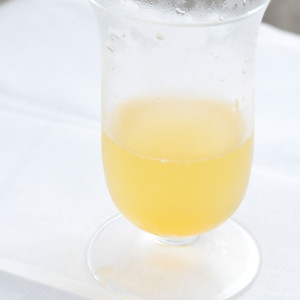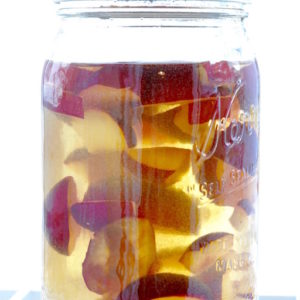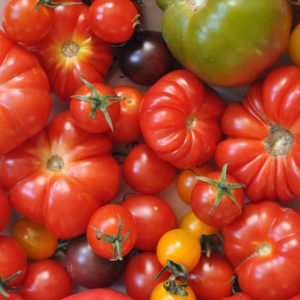Summer Fruit Cordials
I love to drink.

The above sentence is a rule-breaker. Grammarians frown on beginning sentences with “I”. The anti-temperance league frowns on drinking. So do the D.A.R.E. folks, who were tabling outside the market where I bought bourbon this morning. And admitting a fondness for alcohol is unseemly, particularly if you are female.
Note I did not say I love getting drunk, a state I am physically incapable of achieving. I’m a lightweight. My body is its own bartender/bouncer, tossing itself out the back door after a mere couple drinks. But before reaching that point, alcohol is wonderful thing, easing various aches and pains, soothing the savage gut, and calming the stressed soul.
Most of the time I stick with bourbon or scotch, springing for Calvados or Armagnac when finances permit. Summer fruit cordials are a recent, delicious development. They’re easy, cheap, and require nothing by way of skill or equipment.
According to Amy Stewart’s The Drunken Botanist, ume is a Chinese species of of the plum family. She notes all plums make wonderful liqueuers. Consider the French Mirabelle, which goes into eau-de-vie, the English damson, dropped into gin, and the purple plum, which flavors Eastern European Slivovitz.
Northern Californians are lucky to have abundant supplies of ume, which ripen in June. They’re hard little green fruits, inedible raw. The Japanese pickle them, making umeboshi, or drop them into a white liquor called shochu, adding sugar to create umeshu. Nancy Singleton Hachisu, in her seminal Japanese Farm Food, offers a wonderful recipe for Umeshu calling for vodka and organic sugar. As organic sugar is prohibitively expensive, I opted for regular granulated and am pleased with the result.
Umeshu: Japanese Plum Cordial
Adapted from Nancy Singleton Hachisu’s Japanese Farm Food
½ pound sugar
1 pound ume: Japanese sour plums, washed
3 ½ cups vodka=one bottle plus a bit from a second; I used Tito’s vodka.
Here’s what the jar looked like on May 8, 2015:

Put the sugar, ume, and vodka into a sterilized quart jar with a lid. Cap tightly, label, and store in a cool, dark place for three months. A closet or cool kitchen cupboard works well.
After three months, taste. If you like it, refrigerate if you wish; you can also store in freezer. Serve in shot glasses as an aperitif. Keeps indefinitely, though you are unlikely to have it that long. Here’s what mine looks like now:

The taste? Smooth, not too sweet, wonderful chilled. Light, haunting, almost ephemeral. The liquor has taken on the color of old linen. The kind of thing you feel almost melancholy drinking, because there won’t be more until next year, when you’ll have the sense to put up gallons.
Umeshu is bottled commercially. I’ve never tasted it.
Notes: You can also make Apricot Cordial, as I have here, using the same recipe proportions. Mine is still curing and should be ready in October. I began it in July:

Six weeks later, it’s still infusing. Although the fruit is shrunken and the vodka has taken on a pinkish hue, the sugar isn’t entirely dissolved.

And so we wait.
The hardest part.
Amy Stewart’s The Drunken Botanist is a terrific resource. Subtitled “The Plants The Create The World’s Great Drinks”, the book offers detailed historical information on herbs, spices, plants, trees, shrubs–anything and everything that can be distilled, fermented, or otherwise made alcoholic. Humorous and accessible, even for the black-thumbed (ahem). Published in 2013 by Algonquin Press.




